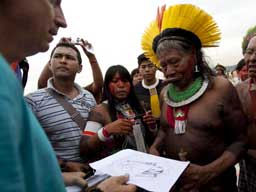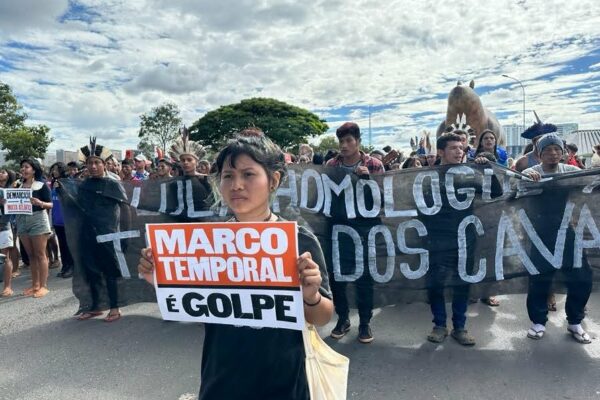High-res photos available here; b-roll available upon request.
Río de Janeiro, Brazil – Nearly 1500 people used Rio’s Flamengo Beach as a canvas today, their bodies forming the lines of an enormous image promoting the importance of free-running rivers, truly clean energy sources like solar power and including indigenous knowledge as part of the solution to climate issues. The activity was led by Brazil’s many indigenous peoples organized under the umbrella of the Articulation of Brazilian Indigenous Peoples (APIB) and comprising the majority of the “human banner” participants.
The human banner symbolized the important role of indigenous knowledge and a strong preference for meeting our collective energy needs through renewable sources like solar power. Giant text below the image read, “Rios para a vida” (“Rivers for life”) signifying that rivers should be dedicated to supporting the life of the millions of humans who depend on them and that they should remain undammed.
Legendary Kayapó leader Chief Raoni participated in the event, bringing a colorful group of Kayapó warriors. “We need a movement to call attention to the Brazilian government and the world to stop these dams. How can the people live without the flowing rivers and their fish and forests?” Referencing the impending construction of the Belo Monte dam he wrote, “I’m concerned about all the people suffering as they lose their lands and homes.”
The image was an artistic collaboration between world-renowned aerial artist John Quigley and a visionary committee of indigenous peoples including Aldamir Sataré-Mawé (Amapá), Sheyla Juruna (Pará), Dione Vison Terena (Mato Groso do Sul), Augusto Kaigamg (Rio Grande do Sul), and Capitao Potuguara. John previously worked with Brazilian indigenous peoples to create the “Salve a Amazonia” human banner in 2009 and more recently the “Pare Belo Monte” banner along the Xingu River last Friday, an aerial photo of which has gone viral on social media.
“We want to tell the world that the rivers, people and the planet need to be saved. The message of the banner is that we can live more sustainably, respecting the Earth’s people and without destroying its natural resources,” said indigenous leader Sheyla Juruna. Her community will likely be destroyed as the Big Bend section of the Xingu River dries up to divert the waters for the Belo Monte dam.
“A country [Brazil] that wants to be fair and democratic, and that aims to be the fifth world power, must respect its native people,” said Romancial Cretã of Brazil’s Kaingang People. “It has to guarantee its citizens basic rights, as the rights to land and education are essential to the survival of these people. Only then we will achieve real progress.”
The indigenous leaders were joined by a number of steadfast international supporters and allies.
“Today we stand with Brazil’s indigenous peoples to send a message that rivers represent the lifeline of millions of people and must be protected,” said Atossa Soltani, Executive Director of environmental organization Amazon Watch. “The more than 70 large hydroelectric dams planned for the Amazon over the next 20 years spells disaster for the Amazon, large dams are not “clean” energy. We are sounding alarm bells that rivers of the Amazon are under attack in the name of unnecessary hydroelectric power.”
The United Nations has declared 2012 the year of “sustainable energy for all” and clean energy will be a major focus at the Rio+20 conference. Within this context, the artwork sparked dialogue around the need for a truly clean energy strategy based on principles of economic efficiency, environmental sustainability, social justice, democratic participation, and including indigenous knowledge as part of the solution.
“The knowledge of our ancestors can show us the way of how the human race can be in harmony with the planet and live in a sustainable form,” said Sonia Guajajara, Vice President of COIAB and part of the National Articulation of Indigenous Peoples of Brazil.
“We have all the lessons from the past, they just have to be learned” said Paul Horsman, Campaign Director for the Global Campaign for Climate Action, an alliance of over 350 organizations that runs the tcktcktck campaign for a fair and ambitious international climate treaty. “Big dams, coal and nuclear power are outdated structures, the future belongs to clean power from the sun and wind. We have the solutions, we know the technology works, all that is missing is the political will and the action.”














